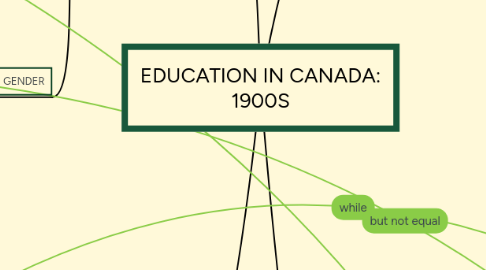
1. DISCRIMINATION
1.1. MINORITIES
1.1.1. Asians
1.1.1.1. British Columbia
1.1.1.2. administrators gave tests
1.1.1.2.1. in order to determine "intelligence"
1.1.1.2.2. standardized testing
1.1.2. defined as: non-British immigrants
1.1.3. Assimilation
1.1.3.1. Aboriginals
1.1.3.1.1. integrate into mainstream "white" society
1.1.3.1.2. government goal
1.1.3.1.3. Residential Schools
1.1.3.2. Immigrants
1.1.3.2.1. Prairie Schools
1.2. GENDER
1.2.1. 1910
1.2.1.1. elementary urban school salary
1.2.1.1.1. women: $300-1000
1.2.1.1.2. men: $600-1400
1.2.1.2. secondary
1.2.1.2.1. women: $800-1000
1.2.1.2.2. men: $1000-2100
2. QUEBEC
2.1. early 1900s
2.1.1. lower overall attendance
2.1.2. children learned trades outside of school
2.2. 1946
2.2.1. rural and urban teachers form first teaching organisation
2.2.1.1. “Corporation generale des instituteurs et institutrices catholiques du Quebec”
2.2.2. now
2.2.2.1. represents various people employed in education sector
2.2.2.2. never connected with CTF
2.3. The Quiet Revolution
2.3.1. Department of Public Instruction formed
2.3.1.1. 1500 school boards province-wide
2.3.2. inquiry launched into current conditions
2.3.2.1. MAJOR CHANGES
2.3.2.1.1. Liberal government
2.3.2.1.2. Catholic Church's control over education
2.3.2.1.3. huge budget increase
2.3.3. Aftereffects
2.3.3.1. education seen as important factor to civilization
2.3.3.2. guarantee economic competition
2.3.3.3. learning
2.3.3.3.1. became less humanitarian
2.3.3.3.2. became more math/science based
3. LAWS
3.1. Bill 101
3.1.1. in 1970s
3.1.2. immigrants to Quebec
3.1.3. education in French was mandatory
3.1.3.1. turning point:
3.1.3.1.1. traditionally wanted to integrate into English society
3.2. Education Act
3.2.1. gives provinces/territories right
3.2.2. responsible for own education system
3.2.2.1. duties
3.2.2.1.1. class size
3.2.2.1.2. minimum teaching time
3.2.2.1.3. assistants
3.2.2.1.4. scholarships
3.2.2.2. benefits
3.2.2.2.1. insurance
3.2.2.2.2. pensions
3.2.2.2.3. retirement
3.2.2.2.4. sick leave
3.2.2.3. transportation
3.2.2.3.1. school bus
3.2.2.3.2. public bus
3.2.3. school zones
3.3. Education Amendment Act (Bill 82)
3.3.1. 1980
3.3.2. special education
3.3.2.1. school board
3.3.2.2. IEP (Individual Education Plan)
3.3.2.2.1. exceptional students
3.3.3. Special Education Tribunals
3.3.3.1. parents can appeal
3.3.3.2. final decision
3.4. Teaching Profession Act
3.5. Section 23 in Constitutional Act
3.5.1. education in both English and French available in most schools
3.5.2. French immersion schools throughout Canada
4. METHODS
4.1. TEACHERS
4.1.1. 1910
4.1.1.1. no job security
4.1.1.2. rural conditions
4.1.1.2.1. minimal one-room schoolhouse
4.1.1.2.2. served as janitors
4.1.1.2.3. poor accommodations
4.1.2. after WWI
4.1.2.1. living cost doubles
4.1.2.2. salaries stayed the same
4.1.2.3. begin to form Teacher's Associations
4.1.2.3.1. negotiate pay, tenure, and jobs
4.1.3. 1920
4.1.3.1. Canadian Teachers' Federation (CTF) founded
4.1.3.1.1. at least one such group in every province
4.1.3.1.2. kept secret; labour unions were not trusted at the time
4.1.3.2. 83% full-time teachers female
4.1.4. after WW2
4.1.4.1. $1600 average salary achieved
4.1.4.2. push for teachers to hold degrees
4.1.4.3. university prep becomes mandatory
4.1.5. 1960
4.1.5.1. volunteer in over 50 countries
4.1.6. 1980
4.1.6.1. 55% of teachers female
4.1.7. 1999
4.1.7.1. CTF represents 200,000 elementary/secondary teachers
4.1.7.1.1. member of Education International
4.2. PUBLIC EDUCATION
4.2.1. mandatory
4.2.1.1. until 18 in Ontario, Manitoba, New Brunswick
4.2.1.2. other provinces until 16
4.2.1.3. achievement of secondary school diploma
4.2.2. pre-2000 statistics
4.2.2.1. 99% literacy rate
4.2.2.2. 80.5% have a secondary diploma
4.2.2.3. 53% have post-secondary diploma
4.2.3. school boards
4.3. SECTORS
4.3.1. Military
4.3.1.1. Department of National Defence
4.3.1.1.1. responsible for military colleges
4.3.2. First Nations
4.3.2.1. Department of Indian and Northern Affairs Canada
4.3.2.1.1. education of aboriginal people
4.3.3. Pre-University
4.3.3.1. K-12
4.3.4. Post-secondary
4.3.4.1. mostly funded by province/territory
4.3.4.1.1. rest of money
4.3.4.2. University
4.3.4.2.1. can give students degrees
4.3.4.3. College
4.3.4.3.1. can give students diplomas
4.4. FUNDING
4.4.1. spends 5.4% of GDP on educational sector

